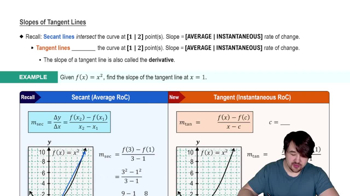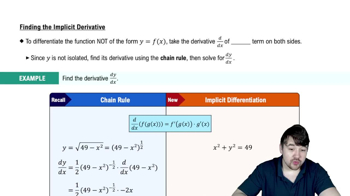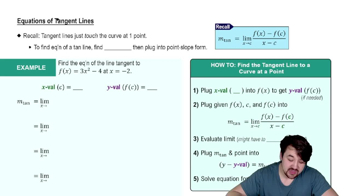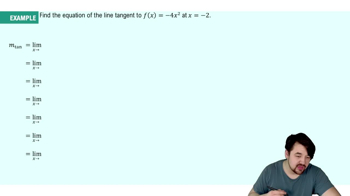Table of contents
- 0. Functions7h 52m
- Introduction to Functions16m
- Piecewise Functions10m
- Properties of Functions9m
- Common Functions1h 8m
- Transformations5m
- Combining Functions27m
- Exponent rules32m
- Exponential Functions28m
- Logarithmic Functions24m
- Properties of Logarithms34m
- Exponential & Logarithmic Equations35m
- Introduction to Trigonometric Functions38m
- Graphs of Trigonometric Functions44m
- Trigonometric Identities47m
- Inverse Trigonometric Functions48m
- 1. Limits and Continuity2h 2m
- 2. Intro to Derivatives1h 33m
- 3. Techniques of Differentiation3h 18m
- 4. Applications of Derivatives2h 38m
- 5. Graphical Applications of Derivatives6h 2m
- 6. Derivatives of Inverse, Exponential, & Logarithmic Functions2h 37m
- 7. Antiderivatives & Indefinite Integrals1h 26m
- 8. Definite Integrals4h 44m
- 9. Graphical Applications of Integrals2h 27m
- 10. Physics Applications of Integrals 2h 22m
2. Intro to Derivatives
Tangent Lines and Derivatives
Problem 3.2.76
Textbook Question
Vertical tangent lines If a function f is continuous at a and lim x→a| f′(x)|=∞, then the curve y=f(x) has a vertical tangent line at a, and the equation of the tangent line is x=a. If a is an endpoint of a domain, then the appropriate one-sided derivative (Exercises 71–72) is used. Use this information to answer the following questions.
Graph the following curves and determine the location of any vertical tangent lines.
a. x²+y² = 9
 Verified step by step guidance
Verified step by step guidance1
First, recognize that the given equation x² + y² = 9 represents a circle centered at the origin with a radius of 3.
To find vertical tangent lines, we need to express y as a function of x. Rearrange the equation to solve for y: y = ±√(9 - x²).
Differentiate y with respect to x to find the derivative y'. For y = √(9 - x²), use the chain rule: y' = (1/2)(9 - x²)^(-1/2) * (-2x). Simplify to get y' = -x / √(9 - x²).
Consider the limit of |y'| as x approaches the endpoints of the domain of y. The domain of y is -3 ≤ x ≤ 3. Check the behavior of y' as x approaches ±3.
As x approaches ±3, the denominator √(9 - x²) approaches 0, causing |y'| to approach infinity. This indicates vertical tangent lines at the points where x = ±3.
 Verified video answer for a similar problem:
Verified video answer for a similar problem:This video solution was recommended by our tutors as helpful for the problem above
Video duration:
8mPlay a video:
Was this helpful?
Key Concepts
Here are the essential concepts you must grasp in order to answer the question correctly.
Vertical Tangent Lines
A vertical tangent line occurs at a point on a curve where the slope of the tangent approaches infinity. This typically indicates that the function is increasing or decreasing without bound at that point. In calculus, this is identified when the derivative of the function becomes undefined or approaches infinity, suggesting a steep incline or decline.
Recommended video:

Slopes of Tangent Lines
Implicit Differentiation
Implicit differentiation is a technique used to find the derivative of a function defined implicitly by an equation, rather than explicitly as y = f(x). This method involves differentiating both sides of the equation with respect to x and solving for dy/dx. It is particularly useful for curves defined by equations like x² + y² = 9, where y cannot be easily isolated.
Recommended video:

Finding The Implicit Derivative
Endpoints and One-Sided Derivatives
Endpoints of a domain refer to the boundaries of the interval in which a function is defined. At these points, the behavior of the function may differ from that in the interior of the interval. One-sided derivatives are used to analyze the slope of the function from one direction (left or right) at these endpoints, which is crucial for determining the existence of vertical tangents in such cases.
Recommended video:

One-Sided Limits

 5:13m
5:13mWatch next
Master Slopes of Tangent Lines with a bite sized video explanation from Nick
Start learningRelated Videos
Related Practice



